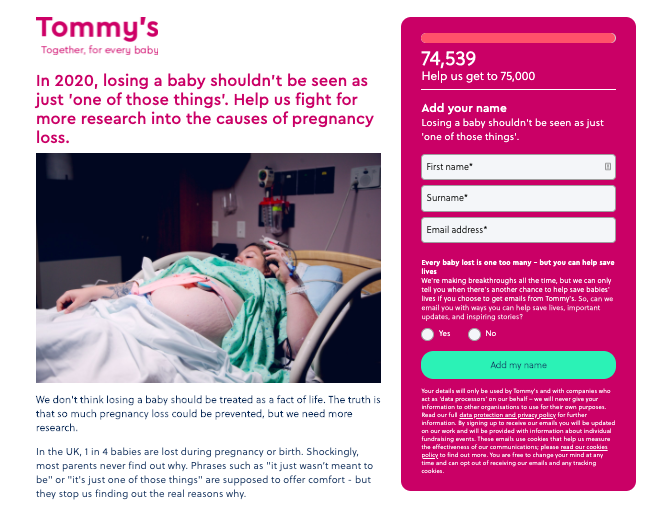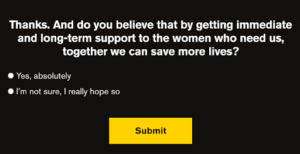When our partners want to reach new supporters and strengthen their digital fundraising, handraisers are often central to the strategy we create together.
If you’ve never used a handraiser as a list growth tool, or if you want to know how they can help with fundraising – here’s what you need to know.
First of all – what is a handraiser?
A handraiser is a sign-up page that compels people to add their name in support of a statement, action, or cause.
It’s a way for people to digitally raise their hand and say ‘yes, I’m with you’.
Charities and organisations use handraisers to find and reach people who support their cause (as well as asking for consent for communications) – making them a vital tool for email list growth, campaigning and fundraising.

Handraisers tend to utilise an emotive values statement like ‘Nobody in the UK should die because they can’t see a doctor’, or a political action such as ‘Sign the official record of opposition to the death penalty’.
When you find a compelling framing (through testing, of course) the amount of new supporters it can bring to your organisation can be incredible. Our partners have recruited up to 100,000 new supporters via a single handraiser.
Fundraising in the post-action sequence
Handraisers are an effective way to recruit new opted-in supporters, but they’re great for fundraising, too.
There are two main ways: asking for donations immediately in the post-action sequence, and fundraising through the email welcome series. Let’s look at those in more detail.
It might seem intimidating to ask for money immediately. Conventional wisdom might say you need to spend time engaging and build a relationship.
But we’ve found post-sign up donation asks can be extremely effective. Your new supporter has just made an emotional connection with your cause and taken their first action (adding their name), which means they’re primed to act.
In a recent handraiser with Refuge, an impressive 2.2% of new supporters donated in the “daisy chain” directly after the sign-up. This meant Refuge recouped 435% of what they spent on Facebook ads to recruit new supporters – before sending a single fundraising email.
Through testing, we’ve found ways to further optimise the post-action sequence. With the IRC, we added a two-question survey that new supporters saw before the donation ask – which increased donation clicks by 45%.


We’ve seen similar trends with other organisations, too. Inviting supporters to reflect on their values and hopes for the future makes it more likely they’ll take further action and donate.
Fundraising in the email welcome series
Once a new supporter joins your email list, it’s time to build a strategic welcome series with a focus on fundraising.
Tap into people’s values, build a warm relationship, and deepen their affinity to your cause by sending regular emails, each with one compelling call to action.
Email actions can include fundraising, of course, plus other campaign asks – signing a petition, writing to an MP, taking a survey or poll, sharing their personal story, sharing a video to social media…
We find that welcome surveys always have high open and click through rates, and adding a soft donation ask to the end of the survey can lead to strong returns.
For example, the welcome survey email we sent for Reprieve generated 20 times the average expected income for a fundraising email – £1 for every recipient.
By the end of the series, Refuge were receiving £4-£6 in donation income for every £1 spent on ads.
Testing and optimising for best practice
Always prototype at least three distinct handraiser concepts to see which leads to the most new supporters and donations at the lowest cost – then roll the winning variant out at scale.
Also test to find the most effective donation ask in your post-action sequence. Try different framings, adding a survey or upsell, or changing the order of the share and donate asks.
When promoting your handraisers with Facebook ads, be sure to test different creative variants and audiences to find which delivers the best results. For example, try retargeting previous donors, creating lookalike audiences, and a variety of different image styles.
And crucially: test different versions of opt-in language to see which converts best. We find that the best performing copy usually links directly to the handraiser, gives a tangible reason to receive emails, and puts the supporter at the heart of the work.
Think: “we can only tell you when there’s another big opportunity to end the death penalty if you click yes” rather than “click yes to get email updates”.
So whether you’re starting with handraisers from scratch, or adding more fundraising elements into your support journey, we think you’ll find this is a cost-effective and engaging way to reach new potential donors. As always – let the data decide.
If you’d like to know more about using handraisers to grow your email list and boost your income, get in touch to see what we can do together.

